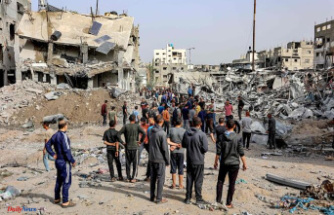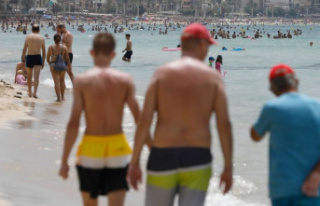France is still suffering from heat and drought. July 2022 is "the second driest month of all months combined" in France since the start of measurements in 1958-1959, behind March 1961. The soils are "even drier than they were on the same date in 1976 and in 2003", emphasizes Météo-France. The institution fears that "the absolute record of dryness of superficial soils, which dates from 2003, has been broken".
Faced with this critical situation, municipalities are adapting. The village of Rogliano, in Haute-Corse, has thus opted for the acquisition of a desalination unit, a first in this Mediterranean island, its mayor, Patrice Quilici, told AFP on Thursday August 4. "We no longer have a choice, we are going to be the pioneers in Corsica to install a desalination unit to produce 500 cubic meters of drinking water per day", indicates the councilor of this village located at the tip of Cap Corse. This desalination unit "must start operating around September 10", he added. Why such a need? Rogliano's drinking water is stored in a reservoir with a capacity of 48,000 m3. However, on August 1, its level was 16,500 m3. Insufficient for a village which "goes from 650 inhabitants in winter to 6000 in season", points out the elected official, and which has already experienced restrictions on the use of water since April 1.
The prefect of Haute-Corse, for his part, called in a tweet on Tuesday August 2 for citizens to reduce their water consumption because "at this rate (...) given the expected weather developments, there will be no more water in 25 days!"
In the Haut-Forez, between Lyon and Clermont-Ferrand, the drop in the level of drinking water in the water towers has led the agglomeration of Montbrison (Loire) to have cisterns transported for the benefit of several municipalities located at altitude. , representing a total population of nearly 4,000 people.
In the Vosges, concern is high in Gérardmer, a resort which was already suffering from increasingly uncertain winter seasons due to global warming. It now faces a summer drought of exceptional intensity and earliness. An "extreme situation", according to the mayor (PS) Stessy Speissmann. The flow from the springs is so low that, since Wednesday August 3, the town has been supplying its public water network with water from the lake. Result: the water is declared undrinkable, a priori for 48 hours, the time to carry out bacteriological tests. This is not a first, but it has never happened "so early", alarms Stessy Speissman.
For the past week, nine municipalities in the Var have meanwhile implemented water restrictions for their inhabitants, due to the severe drought which is drying up the rivers. "Users connected to the public drinking water network will be limited to 200 liters per day and per person for domestic use", evokes the municipal decree of Bagnols-en-Forêt, one of the municipalities concerned. In Seillans, this limit even drops to 150 liters per day for certain districts.
The town hall of Bagnols-en-Forêt has published measures on its Facebook page to give an idea of what different acts are worth in liters of water. Watering with a hose can consume up to 1,000 liters of water per hour, washing your car about 200 liters, a bath between 120 and 200 liters against 40 to 80 liters for a shower, like for a washing machine cycle . For those who exceed these levels, fines of 1,500 euros are planned, but also the installation of a pellet. "It can be installed in offenders and will reduce their water flow in a forced way", explains on Facebook the mayor of Fayence, Bernard Henry.
In Niort (Deux-Sèvres), the city has found a solution to water the green spaces, as related by TF1. The municipality has installed a device to pump the water left by the melted ice of the ice rink, closed to the public since May 19. In Limoges (Haute-Vienne), if the rainwater had already been recovered, there is another reservoir that no one had thought of: the 500,000 liters of a municipal swimming pool. Closed in the summer due to work, it is used to fill small cisterns which are then used by gardeners.
Elsewhere in France, some municipal swimming pools are closed... But for other reasons. While the State is preparing this summer "an energy sobriety plan" to deal with the risk of shortages linked to the war in Ukraine, as Emmanuel Macron declared during his televised speech on July 14, the municipality of 'Issy-les-Moulineaux (Hauts-de-Seine), has decided to close its municipal swimming pool this summer and until the beginning of September. The municipality highlights the additional costs related to the price of electricity. The Alfred-Sevestre swimming pool consumes too much electricity; by closing it, the town hall plans to save 70,000 euros. Some municipalities are following the same path, such as in Saint-Florentin (Yonne), where the swimming pool closed at the beginning of July, the mayor LR Yves Delot estimating that the electricity bill, which rose from 40,000 euros in 2021 to 210,000 euros in 2022 , became too heavy to carry.
Still in order to save energy, many municipalities are now opting to turn off public lighting at night. The trend, already initiated a few years ago, has recently accelerated. Thus, since July 1, the city of Haguenau (Bas-Rhin) has been carrying out an experiment by turning off its nocturnal public lighting in certain districts between 11:30 p.m. and 6 a.m. The town hopes to "make people want to change habits", relates France Bleu.
From midnight to 5 a.m., public lighting in the town of Faches-Thumesnil (Nord) is also cut to save energy. In total, approximately 2,000 light points distributed throughout the city of 17,000 inhabitants are extinguished. As France 3 points out, the list of municipalities reducing public lighting is growing in the North: Cobrieux, Gondecourt, Mouvaux, Lambersart and even Annoeullin, a municipality of more than 10,000 inhabitants which implemented the measure on the 1st august. Because it is "waste" and "waste", according to Jean-Charles Boulonne, assistant for works, roads and security. Similar situation in Lambersart, where the lighting no longer works from 1 a.m. to 5 a.m. This will represent approximately 35% savings in bills, or more than 50,000 euros, estimate the elected officials.
The town of Parmain (Val-d'Oise) has also introduced, since July 1, the extinction of its streetlights from 12:50 a.m. to 4:15 a.m. for a period of six months. This decision comes following an experiment, launched at the end of April, then a survey carried out among the Parminois to know their opinion on the question, relates Actu.fr. For the City, if the main reason for this extinction of lights remains environmental, it is also linked to the soaring price of energy. "With the war in Ukraine, the cost of energy exploded. In two months, our bill increased by 65%. Turning off the lights at night will make us pay more or less the same amount as last year when the lights remained on," said the mayor of the town, Loïc Taillanter.












